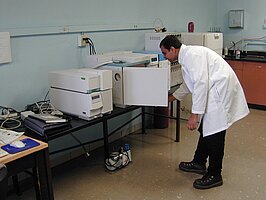Comparative Analysis of Fargo and Moorhead Ozonation Systems

Rahul Bajpai received his B.S. in Civil Engineering from the Punjab Engineering College, India, in June 2001. He is currently pursuing a M.S. in Environmental Engineering at NDSU. Rahul intends to graduate in May 2003.
Rahul is seen here analyzing samples using GC/MS.
Fellow: Rahul Bajpai, Environmental Engineering Program, Department of Civil Engineering, NDSU
Advisor: Wei Lin, Assistant Professor of Civil Engineering, NDSU
Matching Support: Fargo Water Treatment Plant, ND
Degree Progress: M.S. expected in May 2003.
Comparative Analysis of Fargo and Moorhead Ozonation Systems
Both the Fargo (ND) and the Moorhead (MN) Water Treatment Plants (WTPs) use the Red River of the North water as the primary source for providing the drinking water supplies. Both the WTPs employ ozonation followed by biofiltration. The ozonation systems at the MWTP and the FWTP are not only different in design and operation, but also in the purpose they serve at the respective WTP. The Moorhead WTP uses ozone not only for disinfection, but also, for the taste and odor control of the raw water supplies coming in, from the Red River. The Fargo WTP uses ozone only for the purpose of disinfection. Moreover the operating pH at the respective WTPs is different as well. The ozone demand of the both the FWTP and the MWTP is different, though still varying with seasons. Ozone addition to the water leads to the oxidation of the organic matter present in the water and incomplete oxidation results in the formation of ozonation disinfection by-products (DBPs). The major DBPs formed are aldehydes, ketones and carboxylic acids. This research will mainly focus on the amounts of total aldehyde (formaldehyde, acetaldehyde, butanal, glyoxal, methyl glyoxal) formation. Although no significant health effects have been observed from the amounts of aldehydes formed as the DBPs during the drinking water ozonation, these compounds are easily biodegradable. The elevated amounts of these DBPs increase the biodegradable organic carbon (BDOC), and this can lead to accelerated bacterial growth and regrowth in the distribution systems, if the precursors of DBPs formation are not removed or minimized in the WTP during the subsequent operations.
This research is conducted in order to assess the presence of these disinfection by-products and to quantify the amounts of total aldehyde concentration in the treated water. The results will be compared with the study done on the MWTP, for the DBPs amount, and as to how the influent water quality and the operational conditions affect the formation of ozone DBPs. The aldehyde removal across the filters will also be studied.
Three tasks were defined to carry out this project. Task 1 involved literature review on the details of design and operations of the ozonation system at the FWTP and the MWTP, sampling analysis methods, ozone disinfection mechanisms, etc. Task 2 concentrated on collecting samples at different locations so to help achieve the goal of this research and Task 3 is to perform a comparative analysis. As of November 2002, Task 1 has been completed to understand the design and operational controls of the ozonation system at the FWTP. The literature review will continue. Task 2 is underway, but it is very early to start predicting or commenting about the results, but will surely serve as the backbone of the research.


Wei Lin
Civil & Environmental Eng.
Office: Civil/Ind Eng 201D
Telephone: 701-231-6288
Email: wei.lin@ndsu.edu


